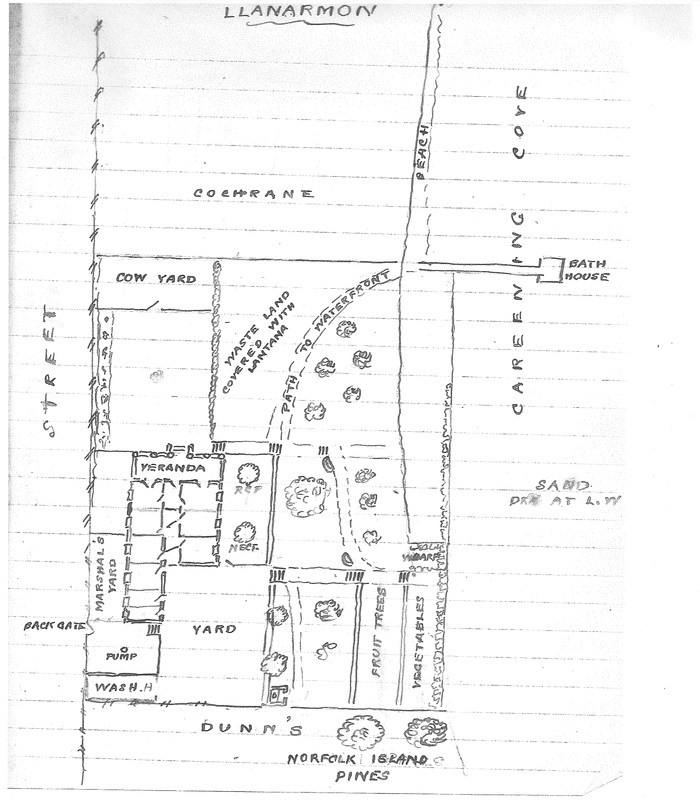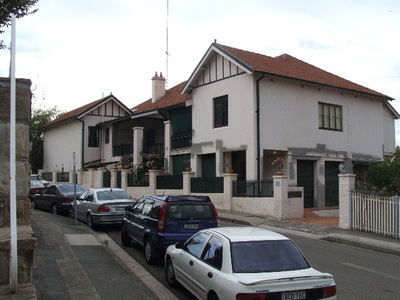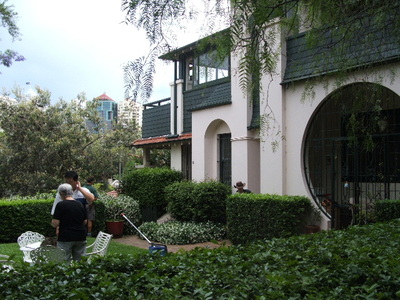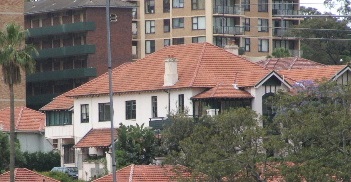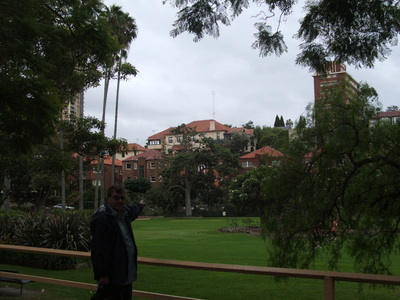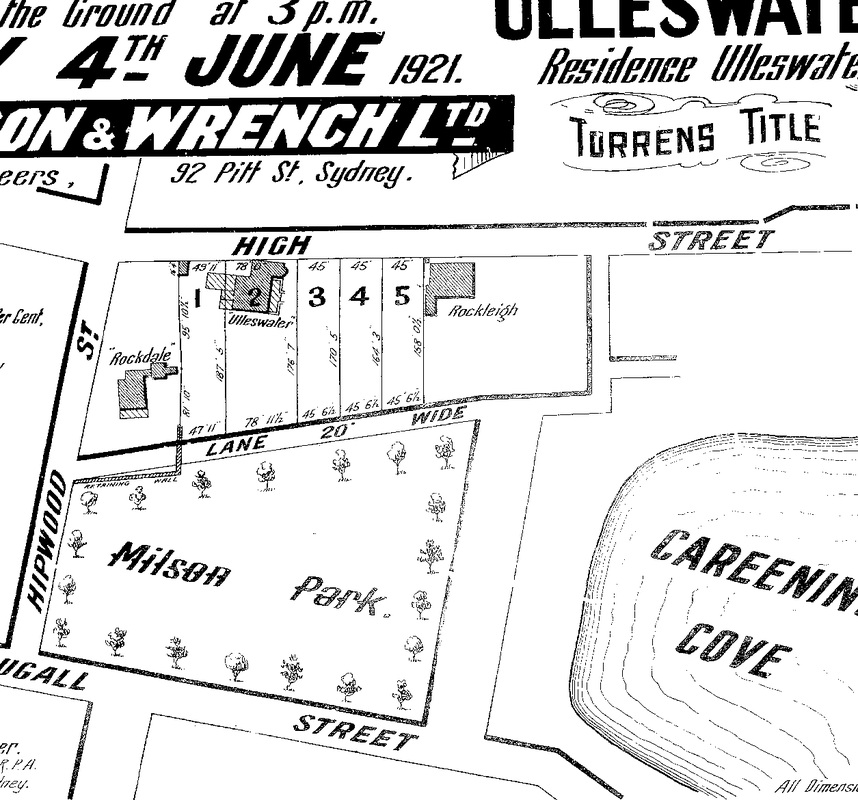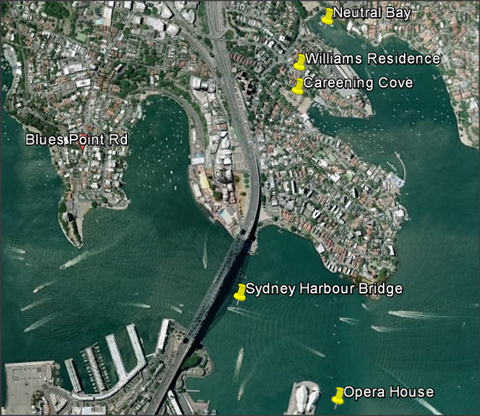
WILLIAM (Willie) WILLIAMS Part 2 – 1865-1870
Careening Cove
By 1865 the Williams family had moved again and were resident in a substantial property in what is now called Careening Cove, one of the more affluent suburbs on the North Shore of Sydney. In 1867 Willie purchased a parcel of land for £26.16.3d.The land measured one acre and 29 perches, between what was then called Whaling Road and is now called High Street and the original water line in the cove below. This parcel was part of a subdivision of land granted to a previous landowner Henry Donnison in 1837. According to a Land Title Deed of October 1880 this parcel comprised Lots 11-14 inclusive of the original subdivision.
Careening Cove has had several names, and at the time of Annie Williams’ death in 1865 it was called Shairps Bay, after the son-in-law of John Milson an early settler. It had also been called Slaughterhouse Bay because there was a slaughterhouse on the shore which provided early Sydney residents with fresh lamb and mutton, and Rainbow Bay after a creek which ran down a gully from the heights of North Shore. The name Careening Cove was finally adopted because it became a popular place for cleaning (careening) the bottom of boats. Cyrus refers to this on the first page of his Journal:
“The bay was called "Careening Cove”, because, being partly filled with clean hard sand it was a suitable place for careening small vessels. Here they came at high water, were scrubbed when the tide went out, and were taken away at the subsequent high water. In my young days (1864-1870), the Milson's Point steam ferry steamers used regularly to be cleaned in this way. They were only small steamers with open cockpits at each [end], and drew only a few feet of water. As the tidal rise at Sydney is only about four to five feet the modern ferry steamers could not be dealt with in this way.”
The head of the Cove eventually became a rubbish dump and was then reclaimed and turned into Milson Park, named for A.G. Milson, Mayor of North Sydney 1909-1913.
The Williams property backed onto High Street which runs along the slope below the ridge line separating Careening Cove and Neutral Bay. The property can be seen today at 107 High Street, and is an imposing property commanding a fantastic view over the Cove and out into Sydney Harbour. It is probably these days divided into apartments or flats.
Cyrus described the property in great detail and at length in his Journal written towards the end of his life:
“Our house was built of sandstone with thick walls. ln front was a cemented veranda roof being supported by round columns with Doric capitals. Beyond the front steps was a lawn, divided from the road or street on the left side by a sloping rocky border with a flower border in front of it; and bounded on the right by a hedge of passion fruit, in which small snakes were common, and were occasionally caught and killed by the house cat. At the far end of the lawn was the cow-yard, and from the right hand out there was a fine view of Sydney harbour, bounded on the right by the sight of Kirribilli Point, Port Denniston being just visible; and on the opposite or Sydney side of the harbour the skyline was marked by the Norfolk Island pines at Fairfax’s house.
Just at the right hand end of our house a set of stone steps carried one down to a terrace about ten feet below the level of the main floor of the house. This terrace was mainly grassed, but at the south end was a large Royal George peach tree, and towards the north end a tree bearing large yellow nectarines, which variety I have never seen since. Both trees were good croppers. From this terrace one entered a cellar extending under the front part of the house and in which were kept all the tools and rubbish which gathers about a house.
This terrace was slightly below the level of the back yard, so that the back of the house was about half a storey Iower than the front, the change of level being brought about by means of corridors, or steps at an angle, at intervals in the back passage, so that the various rooms to the right and left of this passage were at different levels, those on the right being consistently lower than those on the left, in accordance with the slope of the foundation rock, which is very near the surface throughout Sydney and its neighbourhood.
Going out the back door one passed the kitchen, the maid's room, and the man's room, in a wing of the main house parallel with the street and towards that side. At the corner of the man’s room one went up a few steps to the right and along at slightly higher level to the back gate; so that the part of the yard near the back gate was about two foot six higher than the main yard and back door. This raised part covered the arched top of an underground tank or reservoir into which the roof gutters drained and from which water was drawn by means of a pump in the middle.
On the north side between the raised part and the reservoir and the southern boundary of our property was the washhouse at the general yard level, and along the north boundary was a fence on top of a stone wall and the property beyond being at a lower level.
The terrace along the right of the house was one of a series of terraces, held up by dry sandstone masonry walls, extending down to the waters of Careening Cove, the terraces being connected by stone steps and sloping diagonal paths, with here and there a garden seat hewn out of the outcropping sandstone rock.”
Clearly the Williams household was a substantial establishment. Cyrus not only described the property in words, but he also drew a plan of the property which he then pasted into the original handwritten Journal (see scanned copy in photos gallery below). This plan is labelled “Llanarmon” which suggests this was its name when Cyrus lived there. According to Wikipedia “Llanarmon (Llanarmon-yn-Iâl) is a village, and local government community, in Denbighshire, Wales, lying in limestone country in the valley of the River Alyn. Llanarmon was located on several drovers' roads and owed much of its prosperity to the cattle which passed through on their way from Anglesey to the markets of England.”[i]
On the plan he also provides the name of their neighbours – the Cochranes and the Dunns. Cyrus has the following fascinating snippet to recount in relation to the Dunns:
“The property immediately north of ours was occupied or owned by the Dunns, the two old ladies and a son. The latter, Edward Dunn, later met with a tragic death, being accidentally shot by Mr John Milson who used to collect the fares at the Milson's Point ferry. The happening is related on Teddy Dunn's gravestone in St. Thomas’ church yard.”
According to the New South Wales Register of Births, Deaths and Marriages a 15-year old boy Edward Dunn died in the district of St Leonard’s in 1868 and a search of the Australian digitised newspapers website[ii] reveals the full details as told at a Coroner’s Inquest reported in the Empire on Tuesday 9 June 18168. It seems that young Edward August Dunn and his friend had a gun and were trying to shoot gulls from Mr Lord’s wharf in the Cove and John Milson accidentally shot Teddy Dunn when showing them how to load it.
“Between Careening Cove and Neutral Bay the land was only partly occupied. On the right or Careening Cove side were, the Dunns, Williams, Mountcastles, Cochrans and others, and at the end of the point lived Mr Edward Lord, whose son David, or Dodie as he used to be called, was a well-known oarsman and a great hero to us youngsters. He had a small centreboard sailing boat, the “Monkey”, in which he occasionally took us out for a sail.
On the left of the road, between which and Careening Cove were the properties I have mentioned, the ground was covered with tea-tree scrub, called tick-bush on account of the ticks which abounded in it, and had large outcrops of sandstone, in which were many small windblown caves sheltering small wild animals. The top of the main outcrop was flat and from here a good view of the harbour down to Shark Island could be had. This site is now (1932) occupied by a large gasholder.”
A publication dated 1938 lists the earlier residents of the northern side of Careening Cove near what was Whaling Road– Mr Edward Lord (City Treasurer), Mr William Mountcastle (hatter), Mr Williams (solicitor), and Mr William Cochrane.[iii] It is not clear whether the Mr Williams referred to is Willie Williams.
Family Life
After Cyrus’s mother died his paternal grandmother and aunt (Celia and Amy) came to live with the family, presumably to assist Willie with managing his household and bringing up his children. This is referred to in Cyrus’s Journal.
Willie worked for a steam navigation company that plied the coasts and riverine systems of New South Wales to transport goods to markets and consumers and people from one place to another. According to the Sands Directory for Sydney for the years 1858-1859 he was Secretary of the Hunter River New Steam Navigation Company. His name doesn’t appear again in the Directory until 1865, when he is listed as the Secretary of the Clarence & Richmond River Steam Navigation Company[v]. He continues to be listed every year thereafter in the same role until 1872. His name then disappears for a couple of years but he returns to the listings in 1876 as the Assistant Manager of the Australasian Steam Navigation Co.[vi]
Cyrus’s Journal confirms this information when he recounts his father’s involvement in the welcome to Sydney in December 1867 of Prince Alfred, the Duke of Edinburgh. Prince Alfred, Queen Victoria's second son, commissioned the Galatea for a voyage around the world which would include the first royal visit to Australia. Stopping along the way in Rio de Janeiro and Cape Town, Alfred was received with great ceremony at each port of call.[vii] Willie was on one of the fleet of local steam boats which went to the Sydney Harbour Heads to escort the Galatea into port, and he was somewhat annoyed, according to Cyrus’s recollection, about the behaviour of some of the other boats in the fleet.
“My father was the Secretary of the Clarence and Richmond steam navigation company, the small steamers of which traded to the northern rivers of New South Wales, the names of two of which ships I remember as the Agnes Irving and the Ballina. One of the consequences of my father’s official position was that one of the ships under his control was to take part in the demonstration to welcome the Prince on the Galatea.
On the evening previous he brought home a lithographed diagram showing the intended positions and names of the various vessels taking part in the show. They were to steam down the harbour in two parallel lines, and on meeting the Galatea, swing inwards and follow her up to her anchorage in Farm Cove. Although only six years old at the time I distinctly remember my father’s expression of his annoyance, on his return from the demonstration in the evening, when he informed us that a new screw-driven collier, the Waniora was so pleased of her extra speed that she would not keep in her place behind the Ballina. I also remember my father returning from the great picnic at Clontarf and telling us that the prince had been shot by a person named O’Farrel. The prince recovered of the shot, O’Farrel t’was that died, by hanging.”
Willie’s work must have been well-paid as it allowed him to maintain an extensive property and household in one of the smarter suburbs of Sydney at the time. The journey to his place of work would have been an easy one, using the licensed watermen in their skiffs which Cyrus, as was his wont, described thoroughly in his Journal:
“In those days licensed watermen were a feature of the Sydney waterfront, their skiffs being moored at small jetties where the ferry jetties now are, and it was not uncommon for my father to arrive home late at night at our house in Careening Cove, having been rowed home from Circular Quay, as it was then called, or Sydney Cove, in one of the waterman’s skiffs. Such skiffs were twenty-two feet long, five feet beam and twenty inches deep, moulded, amidships; and from these developed the centreboard sailing skiff of similar leading dimensions but vastly different in shape, which were a feature of sailing races in Sydney in the seventies, one of the best of them, the “Effie”, being brought up to Brisbane sometime about 1880.”
Willie seems to have been an affectionate father as Cyrus refers to the erection of a pair of davits on the rocks from which Harold and Cyrus could launch their own rowing skiff “also fitted with a spirit sail. This boat, having no centreboard and being long for its beam, would not “stay”, or go about into the wind, and these deficiencies taught us more genuine seamanship than a properly equipped sailing boat would have done. In this craft we boys used to spend a good deal of our time sailing about Sydney harbour, visiting the ships which in those days used to lie at anchor waiting for their seasonal cargoes, wool or tallow. Among those was the famous “Cutty Sark”, but this was after her leaving the tea trade and having had her spars cut down.”
The boys also had a model yacht, specially made for them:
“One magnificent model, four feet six inches long, a schooner yacht, was the pride of our lives. This boat was made by the foreman shipwright of the A.S.M. Company at the Pyrmont works and given to us boys. We used to sail this yacht in the open water of Sydney harbour, following her in the skiff, and it took us all our time to keep up with her. Her name was “Lady Maud". She was cut out from one piece of wood and ballasted with lead poured in, had no hollow in the garboard, drew about five inches forward and about eleven inches aft, with a straight keel and rounded forefoot. She had the peculiarity of running off before the wind at a certain speed with sheets close hauled, what is technically called “running off the helm”, but was otherwise very fast.”
On the last day of 1870 life for the Williams family changed forever, when Willie remarried.
[i] http://en.wikipedia.org/wiki/Llanarmon-yn-I%C3%A2l
[ii] http://trove.nla.gov.au/ndp/del/printArticlePdf/60853986/3?print=n
[iii] North Sydney 1787-1938: Earliest History and Progress from the Earliest Settlement, by S.V.F Mann, CBE. Published by the authority of the Municipal North Sydney, January 1938 (Staunton Library)
[iv] http://www.cityofsydney.nsw.gov.au/learn/search-our-collections/sands-directory
[v] The North Coast Steam Navigation Co. was founded in 1857 as the Grafton Steam Navigation Co. with the aim of establishing a steamship service between Sydney and the Clarence River. Three years later the company extended its operations to the Richmond River and changed its name to the Clarence and Richmond Rivers Steam Navigation Co. In 1888 following another reconstruction to meet increased demand for its services the company became known as the Clarence Richmond and Macleay Rivers Steam Navigation Co. Finally in 1891 following a merge with a rival organisation the company changed its name to the North Coast Steam Navigation Co. In 1954 it entered into voluntary liquidation. http://acms.sl.nsw.gov.au/item/itemdetailpaged.aspx?itemid=893502
[vi] The company was started as the Hunter River Steam Navigation Company in 1839. In March 1851, the company was reformed as the Australasian Steam Navigation Company. In 1887, the shipping company was amalgamated with the Queensland Steam Shipping Company with their respective vessels in 1887 to form the Australasian United Steam Navigation Company.
[vii] http://www.cambridge.org/co/academic/subjects/history/australian-history/cruise-hms-galatea-captain-hrh-duke-edinburgh-kg-18671868
Careening Cove
By 1865 the Williams family had moved again and were resident in a substantial property in what is now called Careening Cove, one of the more affluent suburbs on the North Shore of Sydney. In 1867 Willie purchased a parcel of land for £26.16.3d.The land measured one acre and 29 perches, between what was then called Whaling Road and is now called High Street and the original water line in the cove below. This parcel was part of a subdivision of land granted to a previous landowner Henry Donnison in 1837. According to a Land Title Deed of October 1880 this parcel comprised Lots 11-14 inclusive of the original subdivision.
Careening Cove has had several names, and at the time of Annie Williams’ death in 1865 it was called Shairps Bay, after the son-in-law of John Milson an early settler. It had also been called Slaughterhouse Bay because there was a slaughterhouse on the shore which provided early Sydney residents with fresh lamb and mutton, and Rainbow Bay after a creek which ran down a gully from the heights of North Shore. The name Careening Cove was finally adopted because it became a popular place for cleaning (careening) the bottom of boats. Cyrus refers to this on the first page of his Journal:
“The bay was called "Careening Cove”, because, being partly filled with clean hard sand it was a suitable place for careening small vessels. Here they came at high water, were scrubbed when the tide went out, and were taken away at the subsequent high water. In my young days (1864-1870), the Milson's Point steam ferry steamers used regularly to be cleaned in this way. They were only small steamers with open cockpits at each [end], and drew only a few feet of water. As the tidal rise at Sydney is only about four to five feet the modern ferry steamers could not be dealt with in this way.”
The head of the Cove eventually became a rubbish dump and was then reclaimed and turned into Milson Park, named for A.G. Milson, Mayor of North Sydney 1909-1913.
The Williams property backed onto High Street which runs along the slope below the ridge line separating Careening Cove and Neutral Bay. The property can be seen today at 107 High Street, and is an imposing property commanding a fantastic view over the Cove and out into Sydney Harbour. It is probably these days divided into apartments or flats.
Cyrus described the property in great detail and at length in his Journal written towards the end of his life:
“Our house was built of sandstone with thick walls. ln front was a cemented veranda roof being supported by round columns with Doric capitals. Beyond the front steps was a lawn, divided from the road or street on the left side by a sloping rocky border with a flower border in front of it; and bounded on the right by a hedge of passion fruit, in which small snakes were common, and were occasionally caught and killed by the house cat. At the far end of the lawn was the cow-yard, and from the right hand out there was a fine view of Sydney harbour, bounded on the right by the sight of Kirribilli Point, Port Denniston being just visible; and on the opposite or Sydney side of the harbour the skyline was marked by the Norfolk Island pines at Fairfax’s house.
Just at the right hand end of our house a set of stone steps carried one down to a terrace about ten feet below the level of the main floor of the house. This terrace was mainly grassed, but at the south end was a large Royal George peach tree, and towards the north end a tree bearing large yellow nectarines, which variety I have never seen since. Both trees were good croppers. From this terrace one entered a cellar extending under the front part of the house and in which were kept all the tools and rubbish which gathers about a house.
This terrace was slightly below the level of the back yard, so that the back of the house was about half a storey Iower than the front, the change of level being brought about by means of corridors, or steps at an angle, at intervals in the back passage, so that the various rooms to the right and left of this passage were at different levels, those on the right being consistently lower than those on the left, in accordance with the slope of the foundation rock, which is very near the surface throughout Sydney and its neighbourhood.
Going out the back door one passed the kitchen, the maid's room, and the man's room, in a wing of the main house parallel with the street and towards that side. At the corner of the man’s room one went up a few steps to the right and along at slightly higher level to the back gate; so that the part of the yard near the back gate was about two foot six higher than the main yard and back door. This raised part covered the arched top of an underground tank or reservoir into which the roof gutters drained and from which water was drawn by means of a pump in the middle.
On the north side between the raised part and the reservoir and the southern boundary of our property was the washhouse at the general yard level, and along the north boundary was a fence on top of a stone wall and the property beyond being at a lower level.
The terrace along the right of the house was one of a series of terraces, held up by dry sandstone masonry walls, extending down to the waters of Careening Cove, the terraces being connected by stone steps and sloping diagonal paths, with here and there a garden seat hewn out of the outcropping sandstone rock.”
Clearly the Williams household was a substantial establishment. Cyrus not only described the property in words, but he also drew a plan of the property which he then pasted into the original handwritten Journal (see scanned copy in photos gallery below). This plan is labelled “Llanarmon” which suggests this was its name when Cyrus lived there. According to Wikipedia “Llanarmon (Llanarmon-yn-Iâl) is a village, and local government community, in Denbighshire, Wales, lying in limestone country in the valley of the River Alyn. Llanarmon was located on several drovers' roads and owed much of its prosperity to the cattle which passed through on their way from Anglesey to the markets of England.”[i]
On the plan he also provides the name of their neighbours – the Cochranes and the Dunns. Cyrus has the following fascinating snippet to recount in relation to the Dunns:
“The property immediately north of ours was occupied or owned by the Dunns, the two old ladies and a son. The latter, Edward Dunn, later met with a tragic death, being accidentally shot by Mr John Milson who used to collect the fares at the Milson's Point ferry. The happening is related on Teddy Dunn's gravestone in St. Thomas’ church yard.”
According to the New South Wales Register of Births, Deaths and Marriages a 15-year old boy Edward Dunn died in the district of St Leonard’s in 1868 and a search of the Australian digitised newspapers website[ii] reveals the full details as told at a Coroner’s Inquest reported in the Empire on Tuesday 9 June 18168. It seems that young Edward August Dunn and his friend had a gun and were trying to shoot gulls from Mr Lord’s wharf in the Cove and John Milson accidentally shot Teddy Dunn when showing them how to load it.
“Between Careening Cove and Neutral Bay the land was only partly occupied. On the right or Careening Cove side were, the Dunns, Williams, Mountcastles, Cochrans and others, and at the end of the point lived Mr Edward Lord, whose son David, or Dodie as he used to be called, was a well-known oarsman and a great hero to us youngsters. He had a small centreboard sailing boat, the “Monkey”, in which he occasionally took us out for a sail.
On the left of the road, between which and Careening Cove were the properties I have mentioned, the ground was covered with tea-tree scrub, called tick-bush on account of the ticks which abounded in it, and had large outcrops of sandstone, in which were many small windblown caves sheltering small wild animals. The top of the main outcrop was flat and from here a good view of the harbour down to Shark Island could be had. This site is now (1932) occupied by a large gasholder.”
A publication dated 1938 lists the earlier residents of the northern side of Careening Cove near what was Whaling Road– Mr Edward Lord (City Treasurer), Mr William Mountcastle (hatter), Mr Williams (solicitor), and Mr William Cochrane.[iii] It is not clear whether the Mr Williams referred to is Willie Williams.
Family Life
After Cyrus’s mother died his paternal grandmother and aunt (Celia and Amy) came to live with the family, presumably to assist Willie with managing his household and bringing up his children. This is referred to in Cyrus’s Journal.
Willie worked for a steam navigation company that plied the coasts and riverine systems of New South Wales to transport goods to markets and consumers and people from one place to another. According to the Sands Directory for Sydney for the years 1858-1859 he was Secretary of the Hunter River New Steam Navigation Company. His name doesn’t appear again in the Directory until 1865, when he is listed as the Secretary of the Clarence & Richmond River Steam Navigation Company[v]. He continues to be listed every year thereafter in the same role until 1872. His name then disappears for a couple of years but he returns to the listings in 1876 as the Assistant Manager of the Australasian Steam Navigation Co.[vi]
Cyrus’s Journal confirms this information when he recounts his father’s involvement in the welcome to Sydney in December 1867 of Prince Alfred, the Duke of Edinburgh. Prince Alfred, Queen Victoria's second son, commissioned the Galatea for a voyage around the world which would include the first royal visit to Australia. Stopping along the way in Rio de Janeiro and Cape Town, Alfred was received with great ceremony at each port of call.[vii] Willie was on one of the fleet of local steam boats which went to the Sydney Harbour Heads to escort the Galatea into port, and he was somewhat annoyed, according to Cyrus’s recollection, about the behaviour of some of the other boats in the fleet.
“My father was the Secretary of the Clarence and Richmond steam navigation company, the small steamers of which traded to the northern rivers of New South Wales, the names of two of which ships I remember as the Agnes Irving and the Ballina. One of the consequences of my father’s official position was that one of the ships under his control was to take part in the demonstration to welcome the Prince on the Galatea.
On the evening previous he brought home a lithographed diagram showing the intended positions and names of the various vessels taking part in the show. They were to steam down the harbour in two parallel lines, and on meeting the Galatea, swing inwards and follow her up to her anchorage in Farm Cove. Although only six years old at the time I distinctly remember my father’s expression of his annoyance, on his return from the demonstration in the evening, when he informed us that a new screw-driven collier, the Waniora was so pleased of her extra speed that she would not keep in her place behind the Ballina. I also remember my father returning from the great picnic at Clontarf and telling us that the prince had been shot by a person named O’Farrel. The prince recovered of the shot, O’Farrel t’was that died, by hanging.”
Willie’s work must have been well-paid as it allowed him to maintain an extensive property and household in one of the smarter suburbs of Sydney at the time. The journey to his place of work would have been an easy one, using the licensed watermen in their skiffs which Cyrus, as was his wont, described thoroughly in his Journal:
“In those days licensed watermen were a feature of the Sydney waterfront, their skiffs being moored at small jetties where the ferry jetties now are, and it was not uncommon for my father to arrive home late at night at our house in Careening Cove, having been rowed home from Circular Quay, as it was then called, or Sydney Cove, in one of the waterman’s skiffs. Such skiffs were twenty-two feet long, five feet beam and twenty inches deep, moulded, amidships; and from these developed the centreboard sailing skiff of similar leading dimensions but vastly different in shape, which were a feature of sailing races in Sydney in the seventies, one of the best of them, the “Effie”, being brought up to Brisbane sometime about 1880.”
Willie seems to have been an affectionate father as Cyrus refers to the erection of a pair of davits on the rocks from which Harold and Cyrus could launch their own rowing skiff “also fitted with a spirit sail. This boat, having no centreboard and being long for its beam, would not “stay”, or go about into the wind, and these deficiencies taught us more genuine seamanship than a properly equipped sailing boat would have done. In this craft we boys used to spend a good deal of our time sailing about Sydney harbour, visiting the ships which in those days used to lie at anchor waiting for their seasonal cargoes, wool or tallow. Among those was the famous “Cutty Sark”, but this was after her leaving the tea trade and having had her spars cut down.”
The boys also had a model yacht, specially made for them:
“One magnificent model, four feet six inches long, a schooner yacht, was the pride of our lives. This boat was made by the foreman shipwright of the A.S.M. Company at the Pyrmont works and given to us boys. We used to sail this yacht in the open water of Sydney harbour, following her in the skiff, and it took us all our time to keep up with her. Her name was “Lady Maud". She was cut out from one piece of wood and ballasted with lead poured in, had no hollow in the garboard, drew about five inches forward and about eleven inches aft, with a straight keel and rounded forefoot. She had the peculiarity of running off before the wind at a certain speed with sheets close hauled, what is technically called “running off the helm”, but was otherwise very fast.”
On the last day of 1870 life for the Williams family changed forever, when Willie remarried.
[i] http://en.wikipedia.org/wiki/Llanarmon-yn-I%C3%A2l
[ii] http://trove.nla.gov.au/ndp/del/printArticlePdf/60853986/3?print=n
[iii] North Sydney 1787-1938: Earliest History and Progress from the Earliest Settlement, by S.V.F Mann, CBE. Published by the authority of the Municipal North Sydney, January 1938 (Staunton Library)
[iv] http://www.cityofsydney.nsw.gov.au/learn/search-our-collections/sands-directory
[v] The North Coast Steam Navigation Co. was founded in 1857 as the Grafton Steam Navigation Co. with the aim of establishing a steamship service between Sydney and the Clarence River. Three years later the company extended its operations to the Richmond River and changed its name to the Clarence and Richmond Rivers Steam Navigation Co. In 1888 following another reconstruction to meet increased demand for its services the company became known as the Clarence Richmond and Macleay Rivers Steam Navigation Co. Finally in 1891 following a merge with a rival organisation the company changed its name to the North Coast Steam Navigation Co. In 1954 it entered into voluntary liquidation. http://acms.sl.nsw.gov.au/item/itemdetailpaged.aspx?itemid=893502
[vi] The company was started as the Hunter River Steam Navigation Company in 1839. In March 1851, the company was reformed as the Australasian Steam Navigation Company. In 1887, the shipping company was amalgamated with the Queensland Steam Shipping Company with their respective vessels in 1887 to form the Australasian United Steam Navigation Company.
[vii] http://www.cambridge.org/co/academic/subjects/history/australian-history/cruise-hms-galatea-captain-hrh-duke-edinburgh-kg-18671868
|
|
